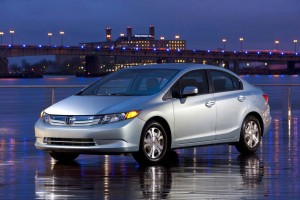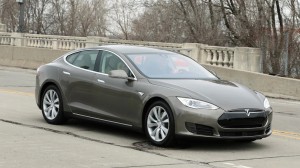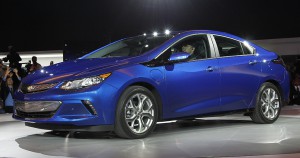At the beginning of 2014, when fuel prices seemed headed for new record highs, U.S. shoppers couldn’t drive off fast enough with small cars and alternative-power vehicles, such as the Toyota Prius and Nissan Leaf.
But with fuel costs down by at least $1 a gallon across the country, manufacturers have been struggling to sell those same, high-mileage vehicles. That’s forced them to stack up new incentives on the hood and, in some cases, slash production.
That poses a challenge for the industry as it faces new fuel economy mandates for 2016 – with even tougher targets phasing in from now until 2025. Even so, automakers show little sign of retreating from the aggressive plans they’ve put in place to introduce new battery-based vehicles and other clean alternatives.
Potentially making them a tougher sell, however, some of the government incentives that helped foster what demand there is for battery-based vehicles could be going away.
(Battery-car sales tumble, but muscle cars are burning rubber out of showrooms. Click Here for more.)
There have been a few rare exceptions. Tesla delivered 11,507 Model S battery-electric sedans during the second quarter, up 52% from the same period a year ago – and a fair jump from the 11,000 target Tesla had previously announced.
But Nissan didn’t have anywhere near that luck with its little Leaf electric, which saw sales dip 23% for the first half of the year, to 9,816. If it maintains that pace, Leaf sales would slip to their lowest level since 2012.
General Motors saw a 35% dip in demand for its Chevrolet Volt, meanwhile, to just 5,622, on top of the 19% decline in 2014. GM is hoping to see things turn around later this year with the launch of an all-new, gen-2 Volt that will deliver more room, more range and better performance. It is also expected to see a drop in price.
GM’s other plug-in hybrid, the Cadillac ELR, has gained some momentum this year, sales climbing 52% in the wake of a $9,000 price cut. But demand slipped again in June by 36%, and total sales for the year to date are just 593.
The various Ford hybrid models slipped about 30% so far this year – with full numbers including June set to be released later today. Sales of the Ford Focus Electric are down 6% through May. Ford recently announced it is dropping a production shift at the plant near Detroit that produces a number of its electrified vehicles, including the C-Max Energi plug-in hybrid.
Honda’s various battery-based vehicles have slipped 21% down the sales charts so far this year. The Japanese maker last month announced it stopped production of both the hybrid and CNG versions of its Civic model. It also halted the Accord plug-in but is working up a new model.
One of the most significant indications of how times have changes comes from Toyota which has long produced the world’s most popular hybrid, the Prius. U.S. demand for the various members of the Prius “family,” including the original hatchback, the compact C and larger V, tumbled 16% for the first half of 2015. And the plug-in version was off 69% — leading Toyota to end its production last month.
Industry-watchers are uncertain about where the market is going, and low fuel prices are just one reason. Several states are rethinking their incentives for alternative power, and others may actually add new fees. Georgia, for one, this week ended a $5,000 state tax rebate for qualified battery-based models. It also added a $200 yearly registration penalty.
Lawmakers in several states, including Oregon, have complained that battery-based vehicles are essentially getting a free ride by paying less to use roads through traditional fuel taxes.
Despite the gloomy numbers, the industry doesn’t appear willing to back down. Not only is General Motors bringing out a second-gen Chevy Volt but it is launching an all-new battery-electric model, the Chevrolet Bolt, that will deliver 200 miles of range per charge – something proponents hope will encourage potential buyers.
Tesla will launch the new Model X electric SUV this summer and is working on a more mainstream vehicle dubbed the Model III.
European makers, late to the hybrid party, are racing to make up lost time. BMW will launch four plug-ins worldwide this year, several earmarked for the U.S. Mercedes-Benz is promising to roll out 10 plug-ins by 2017. Even Bentley is getting into the game with a plug-based version of its new Bentyga SUV in the works.
(BMW speeding up the roll-out of its plug-in line-up. Click Here for more.)
Some manufacturers are betting on clean alternatives to battery technology. Hyundai last year introduced a fuel-cell version of its Tucson SUV and Toyota this week revealed fuel economy numbers for its new Mirai hydrogen car. Honda will debut a fuel-cell vehicle in 2016.
But sales of the Tucson FCV have lagged even Hyundai’s modest expectations, the maker blaming the limited number of hydrogen pumps available – almost all of them in Southern California. That problem is expected to take years to resolve.
(Toyota Mirai fuel-cell vehicle sets a new 67 MPGe benchmark. Click Here to check it out.)





There never was a big demand for hybrids or especially EVs nor will there ever be. That’s bad news for the auto makers (and consumers), as the auto companies will be forced to add a gas guzzler tax onto all cars that do not meet the obscene, pulled-from-their-orifice Obama/EPA decree of 54.5 mpg CAFE mandate. To reduce the gas guzzler tax is the only reason auto makers are trying to dupe consumers into buying an EV or bicycle as Ford is proposing.